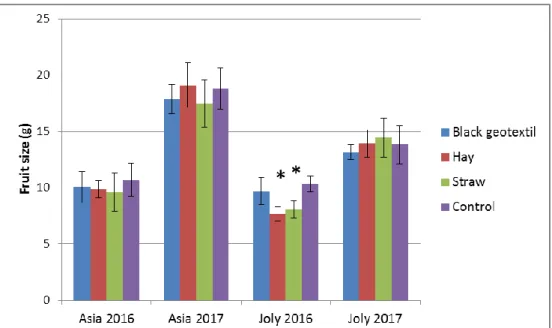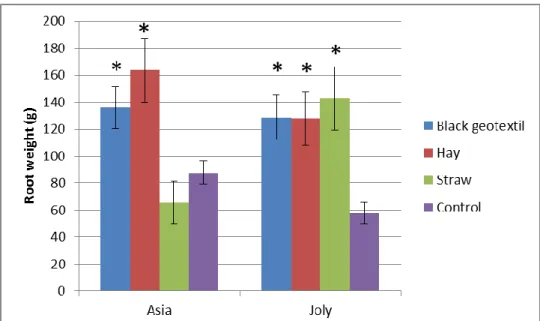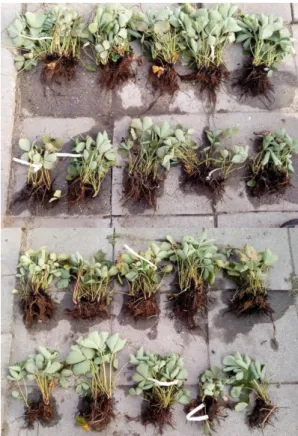CHANGES IN THE VEGETATIVE AND GENERATIVE PARAMETERS OF STRAWBERRY GROWN UNDER
ECOLOGICAL CONDITIONS
Ildikó Király1*, Márton Maczkó1, András Palkovics2 and Virág Mihálka3
1 Department of Horticulture, Faculty of Horticulture and Rural Development, John von Neumann University, Hungary
2 Department of Rural Development, Faculty of Horticulture and Rural Development, John von Neumann University, Hungary
3 Department of Agricultural Science, Faculty of Horticulture and Rural Development, John von Neumann University, Hungary
https://doi.org/10.47833/2020.2.AGR.022
Keywords:
soil covering organic farming strawberry
Fragaria × ananassa ‘Asia’
Fragaria × ananassa ‘Joly’
Article history:
Received 20 Feb 2016 Revised 06 March 2020 Accepted 18 March 2020
Abstract
In our experiment effect of three mulching methods (black geotextile, hay, straw) were investigated on the vegetative and generative parameters of organically-grown strawberry varieties (ʻJoly’ and ʻAsia’). The effect of different mulching methods on yield and fruit quality is not clear from the two-year data, so we continue our experiments. In fresh root mass and root length studies, we found a statistically significant difference between the covered and uncovered areas for both varieties. In the uncovered areas, the root system was less branched than in the covered areas.
1 Introduction
In 2017, 1.4 % of the world’s agricultural area (69.8 million hectares) was organic [26][26].
In organic farming, it is important to protect soil quality and soil life, and to reduce water use, for which purpose mulching can provide a good complementary solution. Depending on the purpose, different materials of organic origin (eg straw, haystack, compost, etc.) or inorganic (eg black polyethylene film, agro-tissue, paper, etc.) can be used for mulching.
Numerous studies with strawberries have shown that the type of mulching material has a direct effect on soil temperature and growth of weeds [3][25]. The method of mulching applied can indirectly influence the qualitative and quantitative parameters of the vegetative and / or generative parts of the plant (eg yield, fruit quality, leaf size, etc.) [2][25].
Mulching mitigates the negative effects of drought stress on growth and yield under semi-arid field conditions [15]. Mulching can also affect the rate of root growth [7].
In our three-year study, we compared the effect of different mulching systems (black geotextile, hay, straw) on the generative and vegetative production of strawberries with the uncovered control plot. The experiment was carried out on dry soil with low humus content, poor nutrient supply and under organic growing conditions. Fruit quality and yield were tested in the planting year and the following year. In the 3rd year, when the experimental plots were liquidated, the development of the root system of plants (fresh root mass, root length, branching) was examined.
* Corresponding author.
E-mail address: kiraly.ildiko@kvk.uni-neumann.hu
Changes in the vegetative and generative parameters of strawberry grown under ecological conditions
2 Material and Methods
2.1 Conditions of the research
The research was carried out among 2016-2018 in the training garden of the Faculty of Horticulture and Rural Development of John von Neumann University, involving two strawberry cultivars (‘Joly’
and ‘Asia’). The frigo plants were planted in a twin-row arrangement with a spacing of 40 + 70 cm by 30 cm at the end of March 2016.
The soil analysis carried out prior to plantation showed that the nitrogen and potassium capacity of the sandy soil was weak, the pH was slightly alkaline and the humus content was low.
Ecological farming is used in the experimental plots therefore we only apply crop-enhancing substances that can be used in organic farming.
Before the plantation 30 t/ha organic fertilizer was deployed into the soil. In the year of the plantation additional nutrients were applied only after the harvest using organic fertilizers (200 g/m2 Greensoil Natural (brown coal from Dudar) and 0.4 kg/m2 Italpollina (pelleted poultry manure)). In the second year from mid-March bimonthly supplementation (200g/m2 Greensoil Natural and 0.4 kg/m2 Italpollina) was performed. At the beginning of the flowering along with the organic nutrients also 40 g/m2 K2SO4 fertilizer was deployed.
In the third year, the nutrient was applied just before flowering with the same fertilizers and in the same quantities as in the previous year.
Three types of soil coverage were used in addition to the uncovered control area: black geotextile, straw and hay. The black geotextile was placed onto the area prior to plantation and the other two mulching materials were applied afterwards. The straw and hay were continuously replaced in the vegetation approx. every month to ensure a cover the thickness of which is minimum 2-3 cm. During the flowering and maturation period the uncovered control plot was covered with straw in order to prevent soil particles from contaminating the fruit. After the harvest the cover was removed.
2.2 Data recording
The fruit parameters and yield were measured on 10 plants in 2016 and on 20 plants in 2017 per treatment. The plants were randomly selected before flowering. During the harvest period we harvested the ripe fruits every 2-3 days and then weighed the fruit (g) on a decimal accuracy scale.
Based on the data, we determined the pieces of fruit per plant (pcs) and we calculated the marketable yield (g/plant).
In 2018 we did not weigh the fruits because the yields were low and the fruits did not reach the minimum required size for fresh market based EU Regulation 543/2011 [1]. In July 2018, after the 3rd harvest, we dug out 5 plants per treatment and carefully washed the soil from the roots. The plants were visually compared according to the following aspects: degree of branching of roots, degree of branching of crowns, development of foliage. After visual inspection, leaves were removed with a 1 cm length petiole, and fresh root mass and root length were measured.
2.3 Statistical analysis
Data were recorded in Excel and then a one-way analysis of variance (ANOVA) (p <0.05) was performed using PAST v3.13 [11]. Because the standard deviations were homogeneous by Levene's test, data were evaluated by Tukey's post hoc analysis.
3 Results and Discussion
3.1 Fruit size
The size of the fruit (Figure 1) in both years (2016: ‘Joly’: 8-10 g/piece; ‘Asia’: 10-11 g/piece; 2017:
‘Joly’: 13-14 g/piece ‘Asia’: 17-19 g/piece) was far behind the average fruit size achieved with conventional cultivation (‘Joly’: 22–34 g/piece; ‘Asia’: 28–30g/piece [12][23]. In 2016 there was a
Figure1. Average fruit size (g/pc) of strawberry cultivars under organic growing conditions (Kecskemét, 2016-2017)
(*significant difference (p<0,05) compared to control)
3.2 Fruit number
In 2016 the average number of fruits were very low (‘Joly’: 4-6 pcs/plant, ‘Asia’: 3-7 pcs/plant), while in 2017 we could harvest a lot more marketable pieces of fruits (‘Joly’: 16- 22 pcs/plant,
‘Asia’: 20-24 pcs/plant) (Figure 2). In 2016 a statistically valid difference (p<0,05) was found between the hay – straw and hay – control in terms of the ‘Asia’ cultivar, and between the black geotextile – straw and straw – control treatments with regards to the ‘Joly’ cultivar. In 2017 the difference was not significant.
Figure 2. Average fruit number (pcs/plant) of strawberry cultivars under organic growing conditions (Kecskemét, 2016-2017)
(*significant difference (p<0,05) compared to control)
Changes in the vegetative and generative parameters of strawberry grown under ecological conditions
3.3 Yield
In 2016 (year 1) the yield (30-70 g/plant) was far behind the expected results when in bearing stage (Figure 3). Cultivation practices consider the year of installation virtually as year 0 due to the weak yield of approx. 100 g/plant. This small amount is generally not marketed, only used for own purpose or is removed due to plant protection reasons (Botrytis).
Since these are intensive cultivars in conventional cultivation, the yield of the cultivars is between 800–1500 g/plant (‘Joly’: 800 g/plant [23]; ‘Asia’: 1000 g/plant [24]. In contrast, under ecological conditions only half of that yield can be achieved. In our 2017 (year 2) experiments (Figure 3) the yield of the ‘Asia’ (360–425 g/plant) approached values reported in the experimental studies performed under ecological conditions (400 g/plant [5]. ‘Joly’ also showed lower yields that year (225–315 g/plant).
In 2016 we could obtain a statistically significant difference (p<0,05) in the ‘Asia’ cultivar between the hay – straw and the hay – control treatments and in the case of ‘Joly’ between the black geotextile – straw and the straw – control treatments. In 2017 only in case of the ‘Joly’ did we find a significant difference between the straw – control treatments.
Figure 3. Average yield (g/plant) of strawberry cultivars under organic growing conditions (Kecskemét, 2016-2017)
(*significant difference (p<0,05) compared to control)
3.4 Root development
Significantly higher root weights were observed for both varieties in the covered areas compared to the control, except in the straw-covered parcel of ‘Asia’ (Figure 4). Significant differences (p <0.05) for root and rhizome weights were obtained between treatments for ‘Asia’ black geotextile – straw, hay – straw and hay – control, furthermore in the case of ‘Joly’ with all treatments compared to control.
Figure 4. Fresh root-weights of srawberry plants in the third year of cultivation when applying different mulching systems (Kecskemét, 2018)
(*significant difference (p<0,05) compared to control)
Regarding root length, the covered areas were also found to have a greater root length relative to the control in both cultivars, except for the ‘Asia’ straw plots (Figure 5). There was a significant difference in root length between the ‘Asia’ black geotextile – straw, the black geotextile – control, hay-straw and the ‘Joly’ black geotextile – control treatments (p <0.05).
Figure 5. Root-length of strawberry-plants in the third year of cultivation when applying different mulching systems (Kecskemét, 2018)
(*significant difference (p<0,05) compared to control)
Our results clearly support the positive effect of mulching on root growth, which is in agreement with the results of many researchers [7].
Visual examination of the whole plant shows that the root system was less branched in the uncovered control area than in the covered areas (Figure 6-7). Mulching results in a more even soil temperature, which is favorable for root development. The most developed foliage and root system was observed on the plants covered with black geotextile, which can be explained by the better
Changes in the vegetative and generative parameters of strawberry grown under ecological conditions
moisture retention effect and the higher soil temperature. Straw and hay cover are also good moisture retention methods compared to controls.
Figure 6. ‘Asia’ strawberry plants in the third year of cultivation
(from top to bottom: black geotextile, hay, straw, control)
Figure 7. ‘Joly’ strawberry plants in the third year of cultivation
(from top to bottom: black geotextile, hay, straw, control)
4 Conclusion
In the first year (2016) the amount of yield is below what can be expected in the year of plantation.
The main reason for this is that at the beginning of ripening we could not provide adequate water supply which had a great effect on the size of the primary fruits. Due to unfavorable experimental conditions, the first year was considered a pre-trial, so only 10 – 10 plants were designated per treatment. In the second year (2017) we increased the number of plants in the study for a more reliable statistical evaluation.
In the second year (2017) the yield was similar to the data available in the literature dealing with organic strawberry cultivation. The ‘Joly’ yield did not reach the expected quantity. We assume that higher yields on higher quality soil are achievable for this cultivar.
The impact of different soil mulching methods on fruit quality and yield is unclear on the basis of the data collected during these two years, so we will continue with the experiments.
Based on our previously published [13][14] and current studies on soil temperature, vegetative and generative performance, it can be stated that each soil cover enhances the condition of strawberries and in most cases yields and fruit quality. Our results confirm the positive effect of mulching on root growth.
Acknowledgment
thematic research network”. The project is funded by the Hungarian State and the European Union, co-financed by the European Social Fund, and is part of the Széchenyi 2020 program.
References
[1] 543/2011 EU rendelet. A bizottság 543/2011/EU végrehajtási rendelete (2011. június 7.) az 1234/2007/EK tanácsi rendeletnek a gyümölcs- és zöldség-, valamint a feldolgozottgyümölcs- és feldolgozottzöldség-ágazatra
alkalmazandó részletes szabályainak a megállapításáról. http://eur-lex.europa.eu/legal-
content/HU/TXT/PDF/?uri=CELEX:32011R0543&qid=1473169898407&from=HU. letöltés: 2016. szeptember 7.
[2] Bakshi, P., Bhat, D.J., Wali, V.K., Sharma, A., Iqbal, M. 2014. Growth, yield and quality of strawberry (Fragaria x ananassa Duch.) cv. Chandler as influenced by various mulching materials. African Journal of Agricultural Research. 9(7): 701-706.
[3] Balci, G., Demirsoy, H., Demirsoy, L., 2017, Evaluation of Performances of Some Organic Waste in Organic Strawberry Cultivation, Waste and Biomass Valorization, https://doi.org/10.1007/s12649-017-0132-6 [4] Birkeland, L., Døving, A., Sønsteby, A. 2002. Yields and Quality in Relation to Planting Bed Management of
Organically Grown Strawberry Cultivars. Acta Hortic. 567: 519-52.
[5] Brockamp, L., Benduhn, B., Rueß, F. 2009. Anbausysteme und Kulturführung im ökologischen Erdbeer- und Strauchbeerenanbau zur Erhöhung der Bestandessicherheit (incl. Strategien gegen Verunkrautung).
Abschlussbericht zum Forschungsprojekt. http://orgprints.org/16788/
[6] Daugaard, H. 2008. The Effect of Mulching Materials on Yield and Berry Quality in Organic Strawberry Production.
Biological Agriculture & Horticulture 26(2): 139-147.
[7] Demirsoy, L., Demirsoy, H., Balci, G. 2012. Different Growing Conditions Affect Nutrient Content, Fruit Yield And Growth In Strawberry. Pak. J. Bot. 44(1): 125-129.
[8] Forcella, F., Poppe, S.R., Hansen, N.C., Head, W.A., Hoover, E., Propsom, F., McKensie, J. 2003. Biological Mulches for Managing Weeds in Transplanted Strawberry (Fragaria × ananassa). Weed Technology. 17(4): 782- 787.
[9] Godin, R., Ela, S., Max, S., Schultz, K., Rohde, J., 2006, Organic Alternatives for Weed Control and Ground Cover Management: Effects on Tree Fruit Growth, Development and Productivity, Technical Bulletin TB06-03,
http://www.colostate.edu/dept/aes/Pubs/pdf/tb06-3.pdf
[10] Gupta, R., Acharya, C.L. 1993. Effect of Mulch Induced Hydrothermal Regime on Root Growth, Water Use Efficiency, Yield and Quality of Strawberry. Journal of the Indian Society of Soil Science. 41(1): 17-25.
[11] Hammer, Ø., Harper, D.A.T., Ryan, P. D., 2001, PAST: Paleontological Statistics Software Package for Education and Data Analysis, Palaeontologia Electronica, 4(1): 9.
[12] http://www.geoplantvivai.com/portfolio/asia-nf421/?lang=en
[13] Király I., Maczkó M., Palkovics A., Mihálka V. 2017. Ökológiai termesztésben alkalmazható talaj takarási módok gyomelnyomó hatása szamócaültetvényben. Jelenkori Társadalmi és Gazdasági Folyamatok. XII (3): pp. 81-87.
[14] Király, I., Palkovics, A., Mihálka, V. 2018. Effect of different mulching systems on the generative product and soil temperature of organically grown strawberry. Book of Abstracts. 6th ICOAS. 7 – 9 November 2018. Eisenstadt, Ausztria. p. 73.
[15] Kirnak, H., Kaya, C., Higgs, D., Gercek, S. 2001. A long-term experiment to study the role of mulches in the physiology and macro-nutrition of strawberry grown under water stress. Australian Journal of Agricultural Research.
52(9) 937 – 943.
[16] Kivijärvi, P. 2006. Weed management with different mulches under organic strawberry production. In: NJF Report, Nordic Association of Agricultural Scientists, 2 (10), p. 35. <http://orgprints.org/10637/1/Lepaa.pdf>. (2016.09.07.) [17] Kivijärvi, P., Parikka, P., Tuovinen, T. 2002. The effect of different mulches on yield, fruit quality and strawberry mite
in organically grown strawberry. In: Organic production of fruit and berries, Nordic Association of Agricultural Scientists. <http://orgprints.org/6188/>. (2016.09.07.)
[18] Kumar, S., Dey, P. 2011. Effects of different mulches and irrigation methods on root growth, nutrient uptake, water- use efficiency and yield of strawberry. Scientia Horticulturae. 127: 318–324.
[19] Pandey, S., Singh, J., Maurya, I.B. 2015. Effect of black polythene mulch on growth and yield of Winter Dawn strawberry (Fragaria × ananassa) by improving root zone temperature. Indian Journal of Agricultural Sciences.
85(9): 1219–1222.
[20] Pires, R.C.M., Folegatti, M.V., Passos, F.A., Arruda, F.B., Sakai, E. 2006. Vegetative growth and yield of strawberry under irrigation and soil mulches for different cultivation environments. Scientia Agricola. 63(5), 417-425.
[21] Sharma, R.R., Sharma, V.P. 2003. Mulch type influences plant growth, albinism disorder and fruit quality in strawberry (Fragaria × ananassa Dusch.). Fruits, 58(4), 221-227.
[22] Singh, R., Sharma, R.R., Goyal, R.K. 2007. Interactive effects of planting time and mulching on ‘Chandler’
strawberry (Fragaria × ananassa Duch.). Scientia Horticulturae. 111(4): 344-351.
[23] Strawberry plant named ‘JOLY’. 2012. US Grant, US PP23126 P3, https://www.google.com/patents/USPP23126 [24] Strawberry plants. Asia Variety specs. http://kraege.de/en/wp-content/uploads/sites/6/2016/01/en_erd-infobrief-
asia.pdf
[25] Wang, S.Y., Galletta, G.J., Camp, M.J., Kasperbauer, M.J. 1998. Mulch Types Affect Fruit Quality and Composition of Two Strawberry Genotypes. HortScience. 33(4): 636-640.
[26] Willer, H, Lernoud, J. 2019. The World of Organic Agriculture. Statistics and Emerging Trends 2019. Research Institute of Organic Agriculture (FiBL), Frick, and, IFOAM – Organics International, Bonn.



